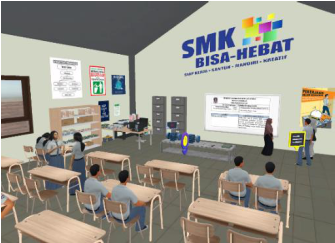The Development of Virtual Reality-Based Electric Motor Rewinding Learning Media for Improving Electrical Equipment Repair Competency in Vocational Schools

Downloads
This development research aimed to develop, assess the feasibility, determine student responses, and evaluate the effectiveness of virtual reality-based electrical motor rewinding learning media in enhancing electrical equipment repair competency at Vocational High Schools. Using the ADDIE model (Analyze, Design, Develop, Implement, Evaluate), the study was conducted at State Vocational High Schools 5 Batam, State Vocational High Schools 7 Batam, and S State Vocational High Schools Teladan Batam. The subjects were 11th-grade students specializing in Electrical Power Installation. Data was collected via interviews, questionnaires, and tests. Expert judgment validated the instruments, and Cronbach Alpha confirmed their reliability. Data analysis involved descriptive statistics and t-tests. The study yielded Virtual Reality based electrical motor re-winding learning media, a guidebook, and job sheets. Feasibility tests showed "very feasible" ratings from both material experts (93%) and media experts (83%). Student responses in the experimental group were "very good" (87%). The media proved effective in improving competency, with experimental group post-test scores significantly higher than the control group. The media demonstrated a "moderate" effectiveness level with a gain score of 0.47, and a t-test value of 0.000 indicated that Ho was rejected and Ha accepted, confirming its effectiveness in enhancing electrical equipment repair competency.
Downloads
[1] S. Maryam, “Pengaruh Pembelajaran IPS dengan Media Teknologi Informasi Komunikasi dan Kompetensi Guru terhadap Minat Belajar Siswa MTSN di Kabupaten Ta-pin,” J. SOCIUS, vol. 3, no. 2, Oct. 2015, doi: 10.20527/jurnalsocius.v3i2.3268.
[2] D. Sisson, P. Brubaker, C. Wilson, and A. Zhang, “An Examination of Student Perceptions of Teacher Social Media Use in the Classroom,” J. Public Relat. Educ., 2021.
[3] D. D. Purwanto, H. T. T. Saurik, and J. I. Hadikusuma, “Teknologi Virtual Reality untuk Media Informasi Kampus,” ResearchGate, vol. 6(1), p. 71, Oct. 2024, doi: 10.25126/jtiik.2019611238.
[4] Undang-Undang Republik Indonesia Nomor 20 Tahun, “Undang-Undang Republik Indo-nesia.” 2003.
[5] C. Yonuari, D. Septiawan, and A. Marcheline, “The The Effect Of Person-Job Fit And Per-son-Organization Fit On Employee Performance With Individual Capacity As Moderation,” Primanomics J. Ekon. Bisnis, vol. 22, no. 3, Art. no. 3, Sep. 2024, doi: 10.31253/pe.v22i3.2900.
[6] Kemendikbud, “Peraturan Menteri Pendidikan dan Kebudayaan Nomor 20 Tahun 2016,” p. 11, 2016.
[7] D. Waraditya, “SMK dan Industri Tak Kunjung Selaras,” Kompas, 2024, [Online]. Availa-ble: https://www.kompas.id/baca/ekonomi/2024/02/06/jutaan-lulusan-smk-selalu-menganggur-ini-biang-keladi-di-mata-industri
[8] N. N. Saputri, W. H. Prasetiyo, and S. Gunarsi, “The influence of teachers’ teaching strate-gies and students’ learning environment on civic learning motivation,” J. Pendidik. PKN Pancasila Dan Kewarganegaraan, vol. 4, no. 2, Art. no. 2, Oct. 2023, doi: 10.26418/jppkn.v4i2.66412.
[9] E. Analyti et al., “Virtual Reality in Education: Transforming Learning through Immersive Technology,” Tech. Educ. Humanit., vol. 10, pp. 1–11, Nov. 2024, doi: 10.47577/teh.v10i.11766.
[10] S. Singh, “Assessing the Benefits and Challenges of Virtual Reality in Education,” Darpan Int. Res. Anal., vol. 12, no. 3, Art. no. 3, Sep. 2024, doi: 10.36676/dira.v12.i3.95.
[11] X. He and W. H. Tan, “Analysis of the Teaching Effectiveness of Virtual Reality Technolo-gy in Higher Education,” Salud Cienc. Tecnol. - Ser. Conf., vol. 4, pp. 1274–1274, Jan. 2025, doi: 10.56294/sctconf20251274.
[12] Peraturan Pemerintah Republik Indonesia, “Peraturan Pemerintah Nomor 29 Tahun 1990.” 1990.
[13] M. Somantri and R. Pramudita, “Enhancing Industry’s Role in Vocational Education: An Analysis of Challenges and Opportunities Based on a Literature Review,” in 2024 9th In-ternational STEM Education Conference (iSTEM-Ed), Jul. 2024, pp. 1–7. doi: 10.1109/iSTEM-Ed62750.2024.10663166.
[14] D. D. Shukla, M. Bhatia, and R. K. Maheshwari, “A Study of the Significance of Vocational Education and Entrepreneurial Skill Generation in Sustainable Economic Development of India,” IJFMR - Int. J. Multidiscip. Res., vol. 6, no. 5, doi: 10.36948/ijfmr.2024.v06i05.28243.
[15] C. A. Prosser and T. H. Quigley, Vocational Education in a Democracy. American Tech-nical Society, 1950.
[16] A. I. Trilaksono, “IMPLEMENTASI KURIKULUM MERDEKA BELAJAR DARI PER-SPEKTIF TENAGA PENDIDIK SMK NEGERI 1 AMPELGADING KABUPATEN MA-LANG,” MAP J. Manaj. Dan Adm. Publik, vol. 7, no. 2, pp. 137–150, Jul. 2024, doi: 10.37504/map.v7i2.618.
[17] S. I. Aprilia, H. Handoko, R. Y. Saputri, and S. D. Oktaria, “Process Assessment Techniques in Online PAI Learning at SDIT Fitrah Insani Bandar Lampung,” Scope J. Engl. Lang. Teach., vol. 8, no. 2, Art. no. 2, May 2024, doi: 10.30998/scope.v8i2.20906.
[18] A. Arsyad, Media Pembelajaran, vol. 3. PT. Raja Grafindo Persada, 2011.
[19] Riyana, “Media pembelajaram,” Dir. Jenderal Pendidik. Islam Kementrian Agama RI, 2012.
[20] R. Asyhar, “Kreatif Mengembangkan Media Pembelajaran,” Referensi Jkt., 2013.
[21] A. Arsyad, “Media Pembelajaran,” PT Raja Graf. Persada, 2007.
[22] N. I. Zuniari, Z. R. Ridlo, S. Wahyuni, E. M. Ulfa, and M. K. S. Dharmawan, “The Effec-tiveness of Implementation Learning Media Based on Augmented Reality in Elementary School in Improving Critical Thinking Skills in Solar System Course,” J. Phys. Conf. Ser., vol. 2392, no. 1, p. 012010, Dec. 2022, doi: 10.1088/1742-6596/2392/1/012010.
[23] M. Miftah and N. Rokhman, “Kriteria pemilihan dan prinsip pemanfaatan media pembela-jaran berbasis TIK sesuai kebutuhan peserta didik,” Educenter J. Ilm. Pendidik., vol. 1, pp. 641–649, Sep. 2022, doi: 10.55904/educenter.v1i9.92.
[24] A. Arsyad, “Media Pembelajaran Edisi Revisi,” PT Raja Graf. Persada, 2017.
[25] Musfiqon, “Pengembangan Media Belajar Dan Sumber Belajar,” Prestasi Pustakakarya, 2012.
[26] S. T. Widodo and P. H. Hastungkoro, Memahami Perbaikan Motor Listrik. Klaten: SAKA MITRA KOMPETENSI, 2017.
[27] S. R. Pressman, Software Quality Engineering: A Practitioner’s Approach, Seventh Ed. New York: McGraw-Hill, 2010.
[28] W. Wibawanto, Desain dan pemrograman multimedia pembelajaran interaktif. Cerdas Ulet Kreatif Publisher, 2017.
[29] J. Lewis, “Multipoint Scales: Mean and Median Differences and Observed Significance Levels,” Int J Hum Comput Interact., vol. 5, pp. 383–392, Oct. 1993, doi: 10.1080/10447319309526075.
[30] D. Kolb, Experiential Learning: Experience As The Source Of Learning And Development, vol. 1. 1984.
[31] R. Branch, Instructional design: The ADDIE approach. 2009. doi: 10.1007/978-0-387-09506-6.
[32] Sugiyono, “Metode Penelitian Kuantitatif, Kualitatif, dan R&D,” Alphabet, 2019.
[33] Kerlinger, “Asas–Asas Penelitian Behaviour,” Gadjah Mada Univ. Press, 2006.
[34] E. Slovin, “Slovin’s Formula for Sampling Technique.,” 1960.
[35] Kemendiknas, “Peraturan Pemerintah Republik Indonesia,” pp. 16–17, 2010.
[36] R. Hake, “Analyzing change/gain scores.,” Am. Educ. Res. Assciation’s Div. Meas. Res. Mhetodology, 1999.
Copyright (c) 2025 Jurnal Edukasi Elektro

This work is licensed under a Creative Commons Attribution-ShareAlike 4.0 International License.
The Authors submitting a manuscript do so on the understanding that if accepted for publication, copyright publishing of the article shall be assigned to Journal.



















